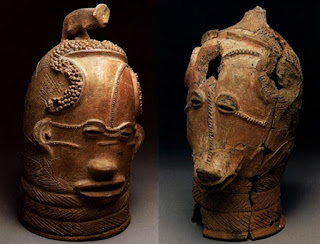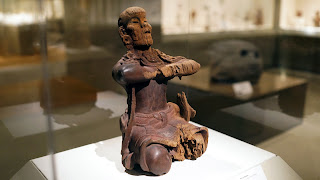Lydenburg Heads
Department of the Arts of Africa, Oceania, and the Americas. “Lydenburg Heads (ca. 500 A.D.).” In Heilbrunn Timeline of Art History. New York: The Metropolitan Museum of Art, 2000–. http://www.metmuseum.org/toah/hd/lyde/hd_lyde.htm (October 2000)
The topic I decided to write about this week is the Lydenburg Heads of Lydenburg, South Africa. The Lydenburg Heads is a set of 7 separate terracotta heads that were discovered in the Eastern part of South Africa, The oldest head is thought to be from around 500 A.D. and the others are thought to be from the same time period because of similarities and details between all of the heads.
Left: one of the "near life sized" heads could be worn over the head. Right: one of the smaller Lydenburg heads. The long snout can be representative of a significant animal or creature.
The Lydenburg Heads are actually the earliest known examples of Iron Age art south of the equator and because of this, the heads are considered a national treasure in South Africa and have been put on display at the national museum in Cape Town.
There are 7 terracotta heads in total. It is said that two of these heads are large enough to fit over the head of a child while the other five are much smaller, about half the size. All of these heads are hollow, and shaped as a inverted U. These and other common attributes between the heads allows archeologists to place them into a group.
There is a lot of speculation on the actual use of these heads but many historians believe that they were used in ceremony.



Comments
Post a Comment